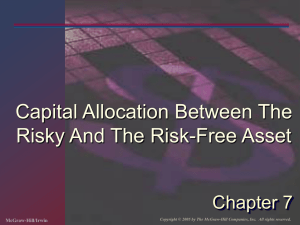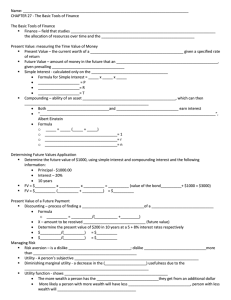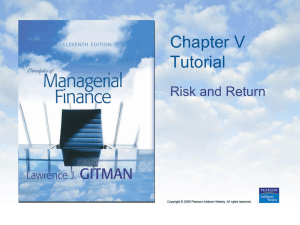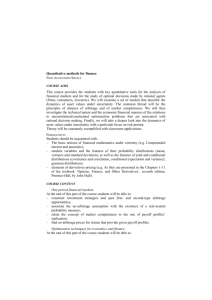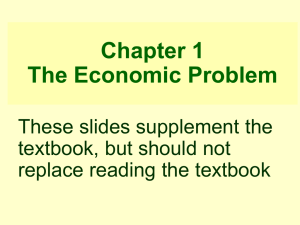Conceptual Summary of lecture 1 and lecture 2
advertisement
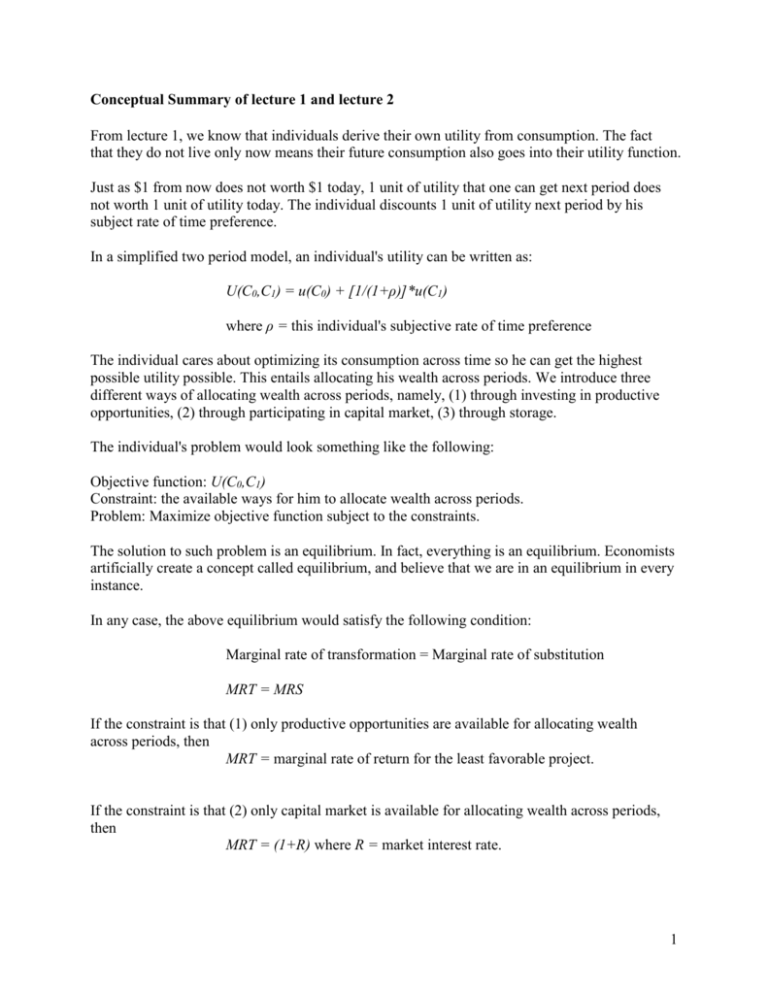
Conceptual Summary of lecture 1 and lecture 2 From lecture 1, we know that individuals derive their own utility from consumption. The fact that they do not live only now means their future consumption also goes into their utility function. Just as $1 from now does not worth $1 today, 1 unit of utility that one can get next period does not worth 1 unit of utility today. The individual discounts 1 unit of utility next period by his subject rate of time preference. In a simplified two period model, an individual's utility can be written as: U(C0,C1) = u(C0) + [1/(1+ρ)]*u(C1) where ρ = this individual's subjective rate of time preference The individual cares about optimizing its consumption across time so he can get the highest possible utility possible. This entails allocating his wealth across periods. We introduce three different ways of allocating wealth across periods, namely, (1) through investing in productive opportunities, (2) through participating in capital market, (3) through storage. The individual's problem would look something like the following: Objective function: U(C0,C1) Constraint: the available ways for him to allocate wealth across periods. Problem: Maximize objective function subject to the constraints. The solution to such problem is an equilibrium. In fact, everything is an equilibrium. Economists artificially create a concept called equilibrium, and believe that we are in an equilibrium in every instance. In any case, the above equilibrium would satisfy the following condition: Marginal rate of transformation = Marginal rate of substitution MRT = MRS If the constraint is that (1) only productive opportunities are available for allocating wealth across periods, then MRT = marginal rate of return for the least favorable project. If the constraint is that (2) only capital market is available for allocating wealth across periods, then MRT = (1+R) where R = market interest rate. 1 If the constraint is that (3) only storage is available for allocation wealth across periods (actually, he is constrained to only save something for future consumption, but not the reverse), then MRT = (1-dep) where dep = depreciation. (If I am to make up a question on storage, I will definitely assume away any depreciation) To conclude, we have MRT = MRS for each of the above 3 cases. Fisher Separation Theorem However, the equilibrium for the individual's problem if both capital market and production opportunities are available is slightly different. And it introduces the very important concept. In equilibrium, if the constraint is that both capital market and production opportunities are available to allocate wealth across periods, and if the capital market line is a straight line (meaning rates of lending and borrowing are the same), the decision of the individual would involve two steps: (1) The individual will participate (invest) in production opportunities up to the point where the least favorable project will yield a rate of return the same as market interest rate. This is a decision purely determined by objective criteria, and such decision maximizes the individual's wealth (as in present value term). (2) The individual then goes to the capital market along with his wealth, and maximize his utility by equating (1+R) = MRS, which may or may not involve borrowing and lending. The equilibrium is such that the production point and the consumption point may likely be different points on the graph. What is so important about Fisher Separation Theorem? This theorem has a few rather handy implications. Among them, the “unanimity principle” is the most striking one. Imagine whole bunch of individual shareholders own a firm. The firm is exposed to a set of production opportunities. Since by definition, utility functions cannot be compared among different individuals. Thus, we simply say different shareholders have different preferences. However, if they are to vote for what production opportunities their firm should take, they will all agree on a single production point where MRT = (1+R) where R = cost of capital. If there is no risk involved, then R is simply the market risk-free interest rate. And thus, every shareholder is unanimous, and they will all agree on a single production point where their joined wealth derived from investing in that firm is maximized. 2 Thus, we can come up with a rather simple rule of selecting projects, i.e., if any project offers rate of return higher than cost of capital, then take it. Chapter 2 E4 provides a discussion of this method. To find out the rate of return of a project (termed as Internal rate of return in the textbook), you select the appropriate internal rate of return such that the net present value of the project is zero. As simple as it is, this rule is not entirely correct. This is called rate of return rule as defined in Chapter 2 of the textbook. This rule is correct if we are dealing with two periods only. And its correctness can be shown using the graph that we illustrate Fisher Separation Theorem. If we are dealing with multiple-periods cash flows, the rate of return rule would be problematic as it assumes all the cash flows generated from this single project from any period would alternatively be invested and earn the same internal rate of return of the project itself. To quote what the textbook says, “IRR rule implicitly assumes that the time value of money is the IRR, since all cash flows are discounted at that rate. This implicit assumption has come to be called the reinvestment rate assumption.”(page 31) This is not a valid assumption. In fact, any cash flow generated from any period can only be assumed to otherwise generate a rate of return equal to the opportunity cost of capital, which is a market-determined rate. And this lays the ground for selecting projects based on their net present value. The simple concept is that if a project generates positive net present value, take it. This is called net present value rule. The production point resulting from such rule is that all independent projects with positive NPV would have been taken. And by Fisher Separation Theorem, this is the point where different shareholders all agree to take because this is the exact production point that maximizes shareholders' present value of wealth, which is the same as maximizing the firm's value, which is also the same as maximizing the share price. The Opportunity Cost of Capital It is easy to calculate Net present value. The supplementary readings are very easy to read and you should be able to compute net present value of projects. A bit of tips for calculating NPV is to draw a timeline. I personally do that every time I calculate NPV to avoid any confusion. There are two important things that I want you to fully understand. The first is the justification of the use of NPV rule to select project, which is already explained above. The second is to have a concept the opportunity cost of capital. We know from the supplementary reading that for any project that is risk-free, we use the riskfree market interest rate to be the opportunity cost of capital. And use it to formulate discount factor to calculate NPV. 3 If a project is risky, we will have to find an equally risky asset. Try to estimate the expected return for that risky asset. And use such expected return as the opportunity cost of capital to discount the future cash flows of the risky project. There are a few things we can learn from such concept. But we have to first define what exactly is "equally risky". Defining it using math can be very fancy, and you don't want to learn from a mathematical definition. In short, if two assets provide the same return in every possible state (i.e., every possible contingency), they are said to be equally risky. And if one of the two assets give a definite level of expected return, say x%, the other asset ought to offer x% as the expected return. This is a concept of no arbitrage, which is perhaps one of the most important equilibrium concept of financial economics. Later in the course, we will be using such concept extensively to value assets. But now, to get a conceptual understanding of it, think of no arbitrage as a stochastic version of the concept "law of one price". "Two identical things must be sold at the same price." Another version of saying such bold statement involves risk, "Two risky assets of the same payoff structure in every possible state must have the same expected return." If they are not having the same expected return, that means one of the two risky assets are underpriced. And this creates opportunity to make instant profit without any risk at all. In general, you short the higher price asset and long the lower price asset to make profit. The precise mechanism of how to arbitrage to make instant profit will be discussed later. Thus, we know for fact that the opportunity cost of capital for a risky asset is the expected return of an equally risky asset. Asset Pricing Since we have already introduced risk, as well as no arbitrage, it is logical to extend to the concept of asset pricing. There are two pieces of good news to everyone: (1) the market rewards risk bearers with higher expected return. (2) the more risk you bear, the higher our expected return. Throughout this course, I want you to learn to understand and appreciate these two pieces of news. I also want you to be able to tell your friends that there is no encouragement whatsoever to try to convince you to take more risk. Because (1) risk-preferences are different for different individuals, (2) the market only rewards some type of risk, but not all risk. There are buyers and sellers of risky assets in the market. Everyone is trying to make profit. And it is because of such unified effort of trying to make profits that virtually eliminates the opportunity to arbitrage. From the above section, we know that in equilibrium, a risky asset would be priced such that its expected return is exactly the same as another risky asset that have the exact same payoff structure. This is again, the no arbitrage condition. The second thing you want to know is how much the market rewards risk, i.e., the equilibrium market price of bearing risk. 4 The third thing you want to know is which type of risk the market rewards. Finally, you want to know what sort of risk the risky asset that you want to value has. These form the basis for asset pricing. There are more to come. And I assure you, they are all microeconomics concepts specially tailored to study the financial market. If you are able to bridge what you are learning from this course with your previous micro course, you will excel in this course. 5
